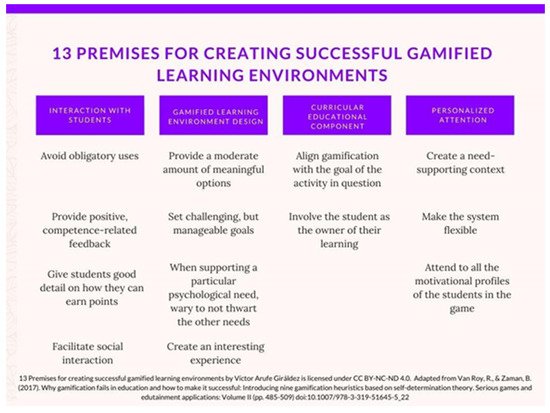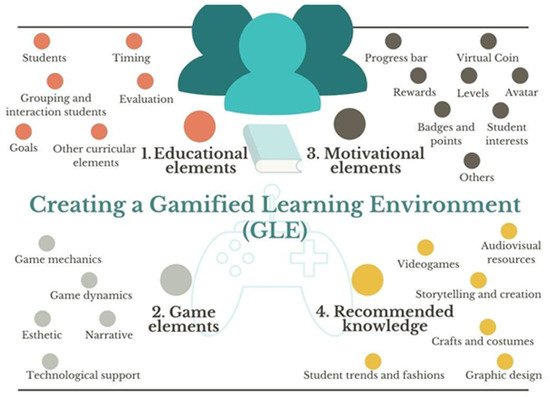You're using an outdated browser. Please upgrade to a modern browser for the best experience.
Please note this is a comparison between Version 1 by Víctor Arufe-Giráldez and Version 2 by Rita Xu.
Gamification along with a whole range of other active methodologies are being incorporated into university classrooms due to their potential benefits for student learning.
- teaching/learning strategies
- gamification
- adult learning
- university
- gamify
- active methodology
1. Gamification as an Active Methodology
One of these methodologies is gamification. Over the last few years there has been an increase in scientific interest in this field [1][9]. Gamification in the educational sphere can be understood as a learning technique which uses elements from games and/or computer games in non-recreational environments, with its main objective being to create behavioural patterns or to encourage certain behaviours in students [2][10]. It can affect the intrinsic and extrinsic motivation of the student and their effort and commitment towards carrying out a certain task [3][4][11,12]. In this sense, its aim is to create attractive and interesting learning experiences that arouse students’ curiosity and capture their continuous attention [5][13]. By means of a systematic review of other empirical studies some authors [6][14] have studied the effects of gamification after its implementation and have confirmed that it can have positive effects, but that these depend on the context in which it is implemented, as well as on the particular users. Another paper [7][15] analysed the impact of a gamified educational experience, showing that it led to an improvement in a few of the studied areas, but a lower performance in others, leading the authors to question some of the common assumptions concerning the benefits of implementing gamification in education. This may be because, as is the case with games and video games, motivation may increase in some people but decrease in others given the ambivalent effect of games, whereby some players may experience feelings of frustration if they do not achieve their purpose [8][16]. Motivation is also influenced by the cognitive and emotional aspects (psychology and neuroscience) of gamification. In this sense, some authors [9][17] uphold the need to establish a cognitive-emotional approach to gamification in order for it to be successful and to engage participants by generating both positive and negative emotions, as there has been little written on how to create emotional experiences through gamification design.
Gamification began in the word of business and quickly caught hold thanks to its level of success in areas such as: improving customer loyalty, worker commitment to their respective companies or the increase in the purchase or contracting of certain products and services [10][11][18,19].
2. The Creation of Gamified Learning Environments (GLEs)
In the sphere of education, it is more correct to speak of the creation of gamified learning environments (GLEs), the design of which is comprised by 4 main blocks and more than 25 key elements [2][10] (see Figure 1).
Other authors, Toda et al. [12][20] have proposed a taxonomy of 21 game elements to be used in GLEs and have organized these elements into 5 categories depending on performance/measurement, environment, social/personal interaction and student experience.
Creating a GLE entails the planning and proper design of the entire process, the steps to be taken, the objectives to be achieved, and the assessment that will measure the attainment of the objectives. Furthermore, it also entails designing all the rules, dynamics, incentive elements and, above all, integrating different areas of knowledge: educational, technological or creative, among others. Van Roy and Zaman [13][21] have pointed out that in order for gamification to be successful in the educational field, nine important premises must be fulfilled, and these have been extended by other authors (see Figure 2).

In theour research, gamification focused on the establishment of a system of points, leaderboards and levels that were awarded to students for carrying out different academic activities voluntarily, to reinforce or expand the knowledge acquired during the development of the subject. Other studies [14][22] that addressed the establishment of a point system in students confirm that employing a combination of game elements such as leaderboard, points system, competition, badges, levels, and immediate feedback can serve as a recipe for interactive learning, hence, improves learning outcomes. A literature review on gamification and e-learning education [15][23] confirmed that within the creation of a gamified learning environment the most common gamification elements used and that have a powerful effect on students are points, leaderboards, the badge and the level. Other authors, Amo et al. [16][24] confirmed in a sample of 88,310 users strong causal evidence of points and classification tables established in a gamified informal learning environment, triggering certain structural and trait competitiveness, which interact to affect both engagement and performance growth in contexts informal learning.
Another important aspect to take into consideration in the creation of a GLE is that it must cater to the four player profiles established by Bartle [17][25] in order to guarantee a minimum degree of motivation for each student, regardless of their motivational profile in the game. These are, the killer player who, further than winning, guarantees the existence of losing players, the achiever player, who will seek to win above everything else, earning points, gathering badges, etc., the explorer player who likes facing new challenges and discovering things that others have not been able to and the socializer player, who prioritises the social aspect and interaction with other colleagues and adversaries over other roles. In this sense, Zaric, Lukarov & Schroeder [18][26] highlight the importance to create a balanced, gamified learning environment in which all learners are equally engaged and interested. However, finding the balance between heterogenic learners’ traits and the variety of gamification design elements is a challenging, multistep process. The study confirmed a positive influence of badges, leaderboards, and experience points on learners with reflective, global, visual, and intuitive learning tendencies.

